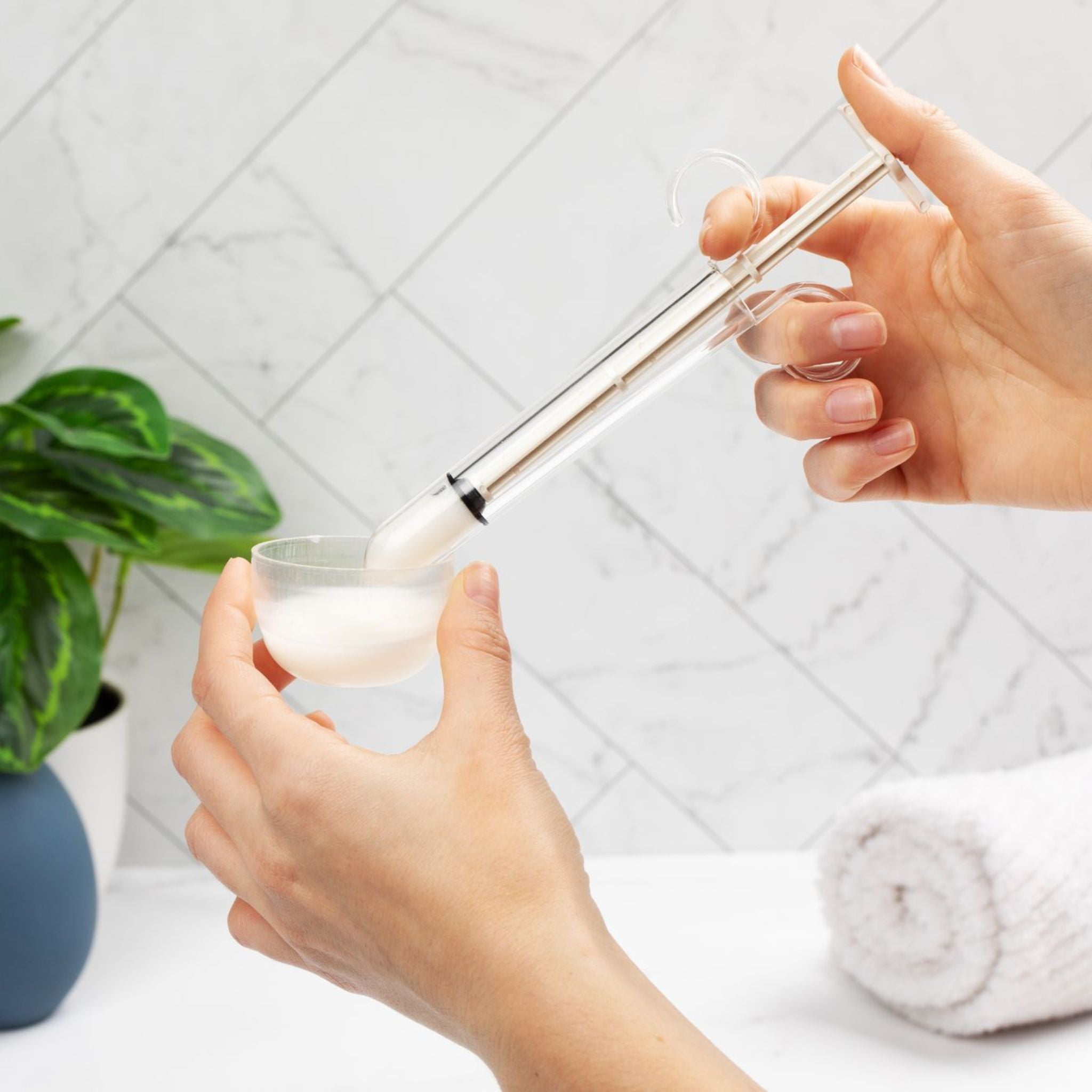Bottom line, the syringe for home insemination is crucial for your success. Here, we explain how it works, why it’s important and important tips for taking your fertility journey in your own hands.
How Home Insemination Works
Intracervical insemination (ICI) is a safe and affordable option for people seeking reproductive assistance in the comfort of their own homes. Better yet, it is equally successful as intrauterine insemination (IUI) performed in fertility clinics.
ICI, also called IVI, involves using a plastic, needle-less syringe to inject sperm into the vagina at the opening of the cervix. The syringe allows the sperm to be placed closer to the uterus, increasing the chances of fertilization.
The sperm needs to be collected in a sterile cup before being placed in the syringe for home insemination. The next step requires you or your partner to insert the syringe into your vagina as far as it will comfortably go before gently pressing the plunger of the syringe and emptying it completely.
It can be helpful to elevate your hips on some pillows to assist with gravity and remain lying down for at least 15-30 minutes after the procedure to give the sperm sufficient time to travel into the uterus. Try doing this before bed, and then don’t get to pee. Although there is little evidence to support the idea that raising your hips makes a difference. But, why not if it might work?
The Importance of the Syringe
The syringe plays a vital role in the insemination process. We have all heard jokes about the turkey baster comparison with in-home insemination. First, gross. Second, that’s not entirely accurate. The truth is that the type of syringe you use can significantly impact your chances of conception which is also why you need to only use an FDA cleared insemination kit.
Most important, the syringe for home insemination must be sterile! And we don’t just mean clean… here’s why.
You have more bacteria cells living in and on you right this minute than you have human cells in your body. All these bacteria form your microbiome, a delicate ecosystem that can impact your health and fertility. When a foreign bacterium is introduced into the ecosystem, it can disrupt the body’s ability to achieve a healthy balance.
Emerging research has proven that women diagnosed with unknown infertility can have a substantial increase in the proportions of 3 different bacteria. The connection between the microbiome and successful conception is finally being researched and understood.
So, how does this connect to the syringe you use?
You may think that all medical-grade syringes are sterile, right?
Unfortunately, not. While the medically safe-looking wrapper on the syringe appears sterile, there is no telling where items were packaged and who has handled them. In addition, sterilization of vaginal applicators is expensive and not required, so companies avoid the process…again…gross.
PherDal is at the cutting edge of insemination science. We understand the importance of the microbiome. Any bacteria on the syringe can disturb your unique ecosystem and harm your chances of conception. The PherDal Kit contains the only patented sterile syringe on the market (3 per kit!) because we don’t want you to disrupt your microbiome. You should have access to the same level of sterility as you would expect in a fertility clinic.
Be Sperm Friendly
The research surrounding microplastics and chemicals disrupting human hormones has rapidly evolved and is reasonably well known. But not many people are aware that the materials used in the syringe and collection cup can impact the quality of the sperm. Yes, that’s right, even a short period of contact with the wrong plastics or harmful chemical adhesives can damage the motility of the sperm.
The syringe you use must be sperm friendly to increase your chances of conception. So be sure to choose an option backed by science. And yes, the PherDal Kit has you covered.
Make Sure It’s Long Enough
The size of the syringe for home insemination is important, not just for your comfort but also for the optimal distribution of the sperm. Of course, it goes without saying, but please do not use a turkey baster!
Jokes aside, you don’t want a syringe that is too small, as it will not reach the cervical opening, and a syringe that is too long may cause discomfort and retain a significant amount of the sperm sample, decreasing your odds of success.
The goldilocks zone is a syringe that holds approximately 5ml and meets the cervix without causing pain.
Moreover, a shorter syringe gives you about the same odds as intercourse. The syringe should be long enough to get the sperm to the opening of the cervix.
The All-Inclusive Kit
You deserve a science-based, FDA-cleared, sterile, and affordable fertility option available in the privacy of your own home. At PherDal, we want to empower people to take control of their fertility journey by combining the sterile environment of the fertility clinic with the at-home capabilities of artificial insemination.
The PherDal at-home insemination kit is leading the industry by including the following:
-
Three single-use PherDal applicators, individually packaged and the only sterilized syringes for home insemination on the market
-
Three collection jars, one for each application, no reusing, which avoids the use of harmful soaps and chemicals
Giving you more than any other kit with three chances of conception in each cycle.
We know how hard the road to conception can be, and we want to support you with the best at-home insemination kit available on the market. The only sterile FDA-cleared, at-home fertility option… because your microbiome is important and sterile matters.





